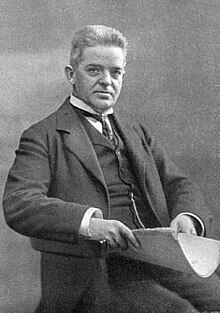Symphony No. 5 (Nielsen)
| Symphony No. 5 | |
|---|---|
| by Carl Nielsen | |

The composer in 1917
|
|
| Catalogue | |
| Performed | 24 January 1922 |
Symphony No. 5, Op. 50, FS 97 is a symphony composed by Carl Nielsen in Denmark between 1920 and 1922. It was first performed in Copenhagen on 24 January 1922 with the composer conducting. It is one of the two of Nielsen's six symphonies lacking a subtitle.
The Fifth Symphony has a non-customary structure, comprising two movements instead of the common three or four. Written in a modern musical language, it draws on the theme of contrast and opposition. The post-World War I composition is also described as having elements of war.
There is no documentation of what inspired Nielsen to write his Fifth Symphony or when he started to write it, but it is generally understood that the first movement was composed in Humlebæk during the winter and spring of 1921. He stayed at his summer house at Skagen in the early summer. At the end of July he moved to a friend's home at Damgaard to compose the cantata Springtime on Funen, and was therefore only able to resume working on the second movement of the symphony in September, during his free time from his conducting work in Gothenburg.
The whole symphony was finished on 15 January 1922, as dated on the score. He dedicated the new symphony to his friends Vera and Carl Johan Michaelsen. Having insufficient rehearsal time, the premiere took place only nine days later, conducted by the composer himself at the music society Musikforening in Copenhagen.
A work from the early 20th century, the Fifth Symphony is regarded as a modernistic musical piece. The symphony draws on all of the "deformation procedures" suggested by James Hepokoski regarding musical modernism: breakthrough deformation, introduction-coda frame, episodes within developmental space, various strophic/sonata hybrids and multi-movement forms in a single movement. Its fragmented nature, unpredictable character and sudden synchronization at the ending also point towards a self-conscious modernist aesthetic, though as in most of Nielsen’s early and middle works, non-modernist devices, including organicism and diatonicism, play some essential roles.
...
Wikipedia
